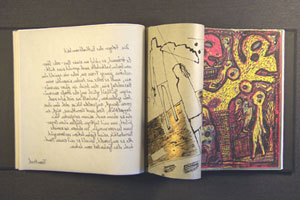|
Edition Augenweide 1987 - 1991 
The article deals with the artists' books produced by Ulrich Tarlatt and Jörg Kowalski, who published their first book in 1987 in the former German Democratic Republic. As the oppressive socialist regime censored every manuscript to crush the opposition's right of free speech, the artists had to find ways to avoid clashing with state bureaucracy. Thus they strictly limited the number of copies published and integrated the text into the illustrations by using silk-screen printing for both. So having been turned into pieces of art, these texts often escaped the notice of the secret police. Tarlatt's and Kowalski's "Edition Augenweide" is, however, not political in the first place. They insist above all on the unlimited freedom of artistic expression. lt seems that they cautiously voiced this demand by constantly relating to the field of dreams in their books which deal with erotic dreams of men (Mein Zahn riesengroß - erotische Männerträume, 1987), dreams dreamt in the twelve nights between Christmas Eve and Epiphany (Rauhnachtträume, 1989), Emperor Frederick Barbarossa, who, as legend has it, is still dreaming in the Kyffhäuser Mountain (Des Kaisers Bart, 1990). Their prophetic visions even evoke evil memories of the so-called German "Reichskristallnacht", the night of pogroms of 9 Nov 1938 when the persecution of the Jewish population openly commenced (Der neugepflanzte Erkenntnisgarten des kabbalistischen Wissens, 1988). Analyzing these books, the reader gradually detects subversive activities behind these dreams: texts by Marx and Lenin are falsified in Der neugepflanzte Erkenntnisgarten ..., Tarlatt's silk-screen prints are sometimes printed on current GDR newspapers, the enthusiasm of certain political groups for the reunification of Germany is attacked in Des Kaisers Bart. It is, however, not primarily political affairs that the artists deal with, but their demand for freedom. The sensual quality of the "Augenweide" books has also to be pointed out: the artists use every imaginable material to convey their ideas - sexy lingerie, suspender belts, a wood-carved totem as spine, magic charms, different kinds of paper, ranging from handmade paper to wrapping paper. Thus the press works towards a synthesis of the arts and manages to evoke emotions that you believed lost long ago. lt has to be added that quite a number of artists have contributed to the books of the "Edition Augenweide", thus turning the press into a forum for the voice of an unknown young German generation reared in oppression but nevertheless standing up courageously for their beliefs. Reinhard Grüner |